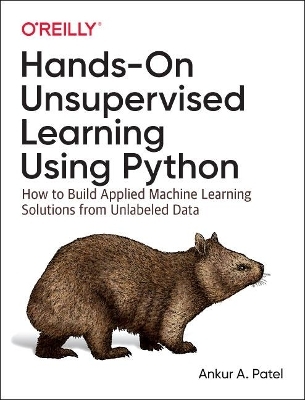
Hands-On Unsupervised Learning Using Python
How to Build Applied Machine Learning Solutions from Unlabeled Data
Seiten
2019
O'Reilly Media (Verlag)
978-1-4920-3564-0 (ISBN)
O'Reilly Media (Verlag)
978-1-4920-3564-0 (ISBN)
Many industry experts consider unsupervised learning the next frontier in artificial intelligence, one that may hold the key to general artificial intelligence. Author Ankur Patel shows you how to apply unsupervised learning using two simple, production-ready Python frameworks: Scikit-learn and TensorFlow using Keras.
Many industry experts consider unsupervised learning the next frontier in artificial intelligence, one that may hold the key to general artificial intelligence. Since the majority of the world's data is unlabeled, conventional supervised learning cannot be applied. Unsupervised learning, on the other hand, can be applied to unlabeled datasets to discover meaningful patterns buried deep in the data, patterns that may be near impossible for humans to uncover.
Author Ankur Patel shows you how to apply unsupervised learning using two simple, production-ready Python frameworks: Scikit-learn and TensorFlow using Keras. With code and hands-on examples, data scientists will identify difficult-to-find patterns in data and gain deeper business insight, detect anomalies, perform automatic feature engineering and selection, and generate synthetic datasets.
All you need is programming and some machine learning experience to get started.
Many industry experts consider unsupervised learning the next frontier in artificial intelligence, one that may hold the key to general artificial intelligence. Since the majority of the world's data is unlabeled, conventional supervised learning cannot be applied. Unsupervised learning, on the other hand, can be applied to unlabeled datasets to discover meaningful patterns buried deep in the data, patterns that may be near impossible for humans to uncover.
Author Ankur Patel shows you how to apply unsupervised learning using two simple, production-ready Python frameworks: Scikit-learn and TensorFlow using Keras. With code and hands-on examples, data scientists will identify difficult-to-find patterns in data and gain deeper business insight, detect anomalies, perform automatic feature engineering and selection, and generate synthetic datasets.
All you need is programming and some machine learning experience to get started.
- Compare the strengths and weaknesses of the different machine learning approaches: supervised, unsupervised, and reinforcement learning
- Set up and manage machine learning projects end-to-end
- Build an anomaly detection system to catch credit card fraud
- Clusters users into distinct and homogeneous groups
- Perform semisupervised learning
- Develop movie recommender systems using restricted Boltzmann machines
- Generate synthetic images using generative adversarial networks
Ankur Patel is an applied machine learning researcher and data scientist with expertise in financial markets. His work focuses on unsupervised learning, natural language processing, time series prediction, and sequential data problems. Currently, Ankur finds hidden patterns in large-scale unlabeled data for clients around the world as a data scientist at ThetaRay, an Israeli artificial intelligence firm. Ankur started his career as the lead emerging markets trader at Bridgewater Associates and later founded and managed the machine learning-based hedge fund R-Squared Macro.
| Erscheinungsdatum | 19.03.2019 |
|---|---|
| Verlagsort | Sebastopol |
| Sprache | englisch |
| Maße | 150 x 250 mm |
| Gewicht | 666 g |
| Einbandart | kartoniert |
| Themenwelt | Mathematik / Informatik ► Informatik ► Datenbanken |
| Mathematik / Informatik ► Informatik ► Programmiersprachen / -werkzeuge | |
| Informatik ► Theorie / Studium ► Künstliche Intelligenz / Robotik | |
| Schlagworte | machine learning • Python • Sci-Kit Learn • tensorflow |
| ISBN-10 | 1-4920-3564-5 / 1492035645 |
| ISBN-13 | 978-1-4920-3564-0 / 9781492035640 |
| Zustand | Neuware |
| Informationen gemäß Produktsicherheitsverordnung (GPSR) | |
| Haben Sie eine Frage zum Produkt? |
Mehr entdecken
aus dem Bereich
aus dem Bereich
Schulbuch Klassen 7/8 (G9)
Buch | Hardcover (2015)
Klett (Verlag)
31,50 €
Buch | Softcover (2004)
Cornelsen Verlag
25,99 €


